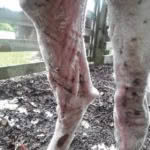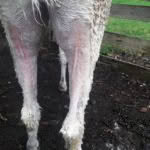All you need to know about alpaca skin disease

Underneath their fluffy fleeces, alpacas are prone to a range of skin conditions. But there are ways to treat them.
Words: Dr Sarah Clews, BVSc
Coming from the dry, arid mountainous regions of South America to the low, relatively humid regions of New Zealand, alpacas have become particularly prone to skin issues. Anyone who has kept these animals can testify to how easily skin disease can take hold and how difficult it can be to treat. While the causes of skin disease in alpacas are nothing outlandish, the symptoms are agonisingly noticeable. Before we delve into what could be going on with your animals, let’s get to the bottom of just what makes their skin so unique.
CAMELID SKIN

Alpacas have thicker skin than other domesticated ruminants. You’ll find it’s particularly thick on the neck and feet. Elsewhere it tends to be similar to a horse. In breeding males with high testosterone, the skin on the neck can be two to three times thicker than normal to protect the jugular from the sharp teeth of other hostile alpacas. Alpacas also have significantly fewer sebaceous glands than other mammals. These are the glands inside our hair follicles that produce the oily substance that coats our skin. In wool-producing animals, it’s called lanolin. Sheep and angora goats, for example, produce lots of lanolin, while alpacas produce very small amounts. This affects them in two ways. Firstly, it increases the risk of clipper burn. And secondly, because lanolin aids the distribution of topical chemicals around the body, alpacas are not affected by drugs as much as other animals. There is, therefore, a limited range of medicines we can use to treat alpacas.
Alpacas are particularly prone to “hyperkeratosis” – a condition involving elephant-like skin spreading over parts of the body in response to inflammation. The skin quickly creates a thick outer layer of keratin (the layer of dead skin cells). Bacteria, yeast and parasites get trapped underneath the thickened skin making treatment difficult and creating a lot of discomfort for the animal.
THE ITCHY ALPACA
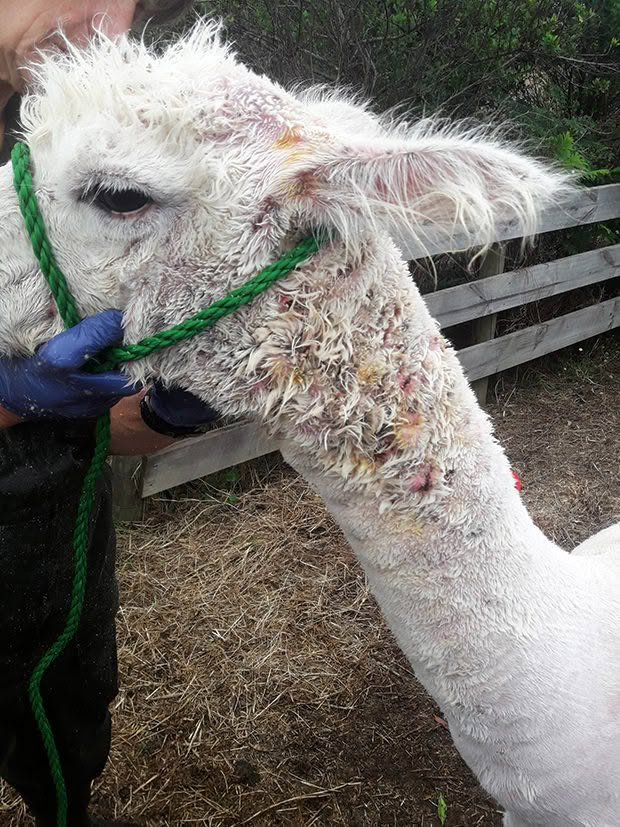
This skin condition is the result of bacterial infection.
The itchy alpaca is so common on lifestyle blocks it’s almost a stereotype. While itchiness is usually caused by external parasites, it‘s not always the case. Secondary bacterial infection is common no matter the underlying cause, which almost always results in itchiness. You can tell if an alpaca has a deep bacterial infection if there are yellowish pustules on the skin, but it’s not always so easy to spot.
Another reason for itchiness in New Zealand alpacas is mange (mites) – the cattle mite (Chorioptes) and scabies (Sarcoptes) being the most common. The scabies mite lives deep down in the skin where it can reach the bloodstream. While it’s incredibly contagious and you’ll need to treat every animal in the herd with high doses of ivermectin, the chances of getting on top of it are actually very good.
The cattle mite, however, is a more frustrating and unpredictable wee being. One alpaca infected with it may come down with severe hyperkeratosis, while others will show no symptoms. It lives for months in covers, halters and fence posts and hides in the outer layer of thickened keratin, making it very difficult to clear with medication. Because there may be only a few mites causing severe symptoms, they’re incredibly hard to find through biopsies. The poor animals end up needing sprays or dips that cover the entire body, as well as high doses of injectable medication, with repeat doses over a prolonged period of time to clear the infestation. Expect life-long management when dealing with this mite.
- An infestation of cattle mite (Chorioptes) before and after treatment. The mites can cause deep fissures and wounds in the thickened skin.
Alpacas carry both sucking lice (that drink the blood) and chewing lice (that eat dead skin debris). Lice are usually found in the densely fleeced areas such as the neck and flanks, and their numbers increase in cold weather. Heavy burdens will drive an alpaca crazy with itchiness, and cause blood and protein loss which will result in weight loss and anaemia. Sucking lice are killed with injectable drugs, but chewing lice need a full body dip or spray. Luckily the sunlight will reduce lice numbers too, so shearing helps.
Many people will have seen dogs that are itchy as a result of environmental allergies. Well, it seems our alpacas suffer a similar thing. Anecdotally we seem to see more allergies in the North Island, perhaps where our climate is more humid and moist year-round. Allergies are usually diagnosed by ruling out everything else and trialling anti-allergy medication. You’ll be in for the long haul with this one.
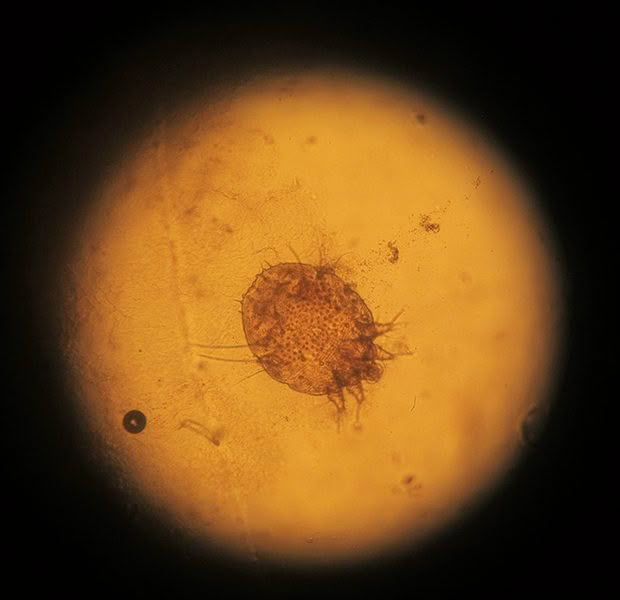
Scabies mite (Sarcoptes scabiei) will need a high dose of ivermectin to treat.
THE DEFICIENT ALPACA
Zinc deficiency can cause skin issues in many species, and we seem to see it in alpacas too, presenting as a thickening of the skin under the armpits and belly. The trouble is, camelids nautrally have low levels of zinc in the blood, so interpreting blood work can be difficult. Some alpacas will respond to zinc treatment despite not actually seeming to be deficient. For this reason, we call the syndrome “zinc-responsive dermatosis”.
While many North Island owners supplement zinc pellets throughout the summer to keep facial eczema at bay, it pays to keep in mind what other foods the animals are eating; high-calcium plants such as lucerne and alfalfa can prevent the absorption of zinc.
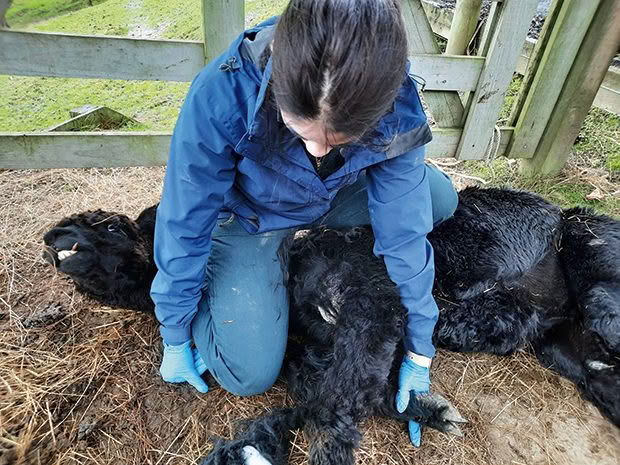
The author assessing an animal with zinc deficiency, which can make the skin susceptible to severe sunburn.
THE BURNT ALPACA
The lack of lanolin in alpaca skin means clipper burn occurs easily, especially if the shearing is done by an inexperienced shearer. Otherwise, we often see burns when an alpaca with thick, matted, overgrown fleece is sheared. This can occur anywhere over the body and causes raw, weeping burn wounds with fleece matted from the discharge. The wounds can take two weeks to heal, but pain relief, skin protectants and antibiotics should be considered to help the process.
Here in New Zealand we also have the joy of dealing with facial eczema, a disease which camelids are particularly prone to. The nasty fungus that causes this disease thrives in late summer in the North Island and damages the liver. What we see from the outside is often severe sunburn of thinly haired areas, most commonly the ears, eyes and nose. To treat this disease you’ll need preventative zinc throughout summer. If you haven’t already, start researching and buying supplements to get through the hot months.
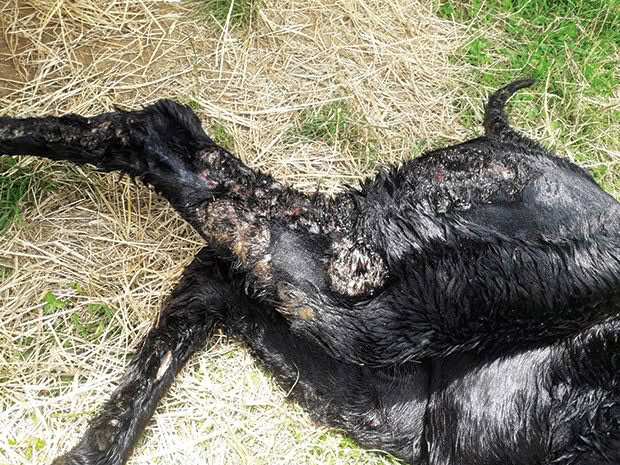
An alpaca suffering from severe skin disease. In these cases, euthanasia may be the only viable option.
THE SMOTHERED ALPACA
Some poor animals become so smothered by skin disease that euthanasia is the only option. While many of the above causes can affect the whole body, two key causes jump to mind: sarcoptic mange and immune deficiency. In these cases, the animal needs immediate relief and rigorous investigation – including blood tests and biopsies – to find the source of disease. Otherwise, humane euthanasia may be the best option.
Love this story? Subscribe now!
 This article first appeared in NZ Lifestyle Block Magazine.
This article first appeared in NZ Lifestyle Block Magazine.
